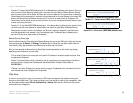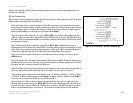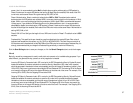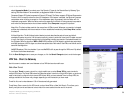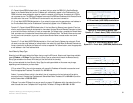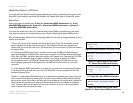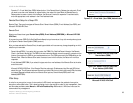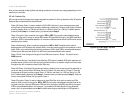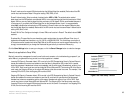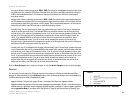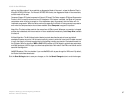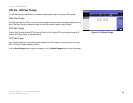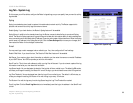
62
Chapter 6: Setting up and Configuring the Router
VPN Tab - Client to Gateway
10/100 16-Port VPN Router
Remote Client Setup for a VPN Tunnel
You will have different Remote Client Setup settings depending on whether you are adding a new tunnel or a new
Group VPN. If you are adding a new Group VPN, proceed to the “Remote Client Setup for a Group VPN” section.
Remote Client
Select one of these five available types: IP Only, IP + Domain Name(FQDN) Authentication, IP + E-mail
Addr.(USER FQDN) Authentication, Dynamic IP + Domain Name(FQDN) Authentication, or Dynamic IP +
E-mail Addr.(USER FQDN) Authentication.
(If you want the remote client to use a Fully Qualified Domain Name (FQDN) for authentication but the remote
client does not have one, visit www.dyndns.org to set up a Dynamic Domain Name System (DDNS) account.)
After you have selected the Remote Client, the settings available on this screen may change, depending on which
selection you have made.
IP Only. If you know the fixed IP address of the Remote Client, select IP Only. Only the computer with this
specific IP address will be able to access the tunnel. In the IP address field, enter the IP address of the
Remote Client at the other end of the tunnel. (The Remote Client can be a computer with VPN client software
that support IPSec.)
IP + Domain Name(FQDN) Authentication. If you select this type, enter the FQDN (Fully Qualified Domain
Name) and IP address of the Remote Client, which can be a computer with VPN client software that supports
IPSec. (Enter the FQDN in the Domain Name field, and enter the IP address in the IP address field.) The FQDN
is the host name and domain name for a specific computer on the Internet. An example of a FQDN is
vpn.remotevpnserver.com. The FQDN and IP address must match the FQDN and IP address of the Local
Security Gateway type selected on the Remote Client. The FQDN and IP can be used for only one tunnel
connection.
IP + E-mail Addr.(User FQDN) Authentication. If you select this type, enter the e-mail address and IP address
of the Remote Client at the other end of the tunnel. (The Remote Client can be a computer with VPN client
software that support IPSec.)
Dynamic IP + Domain Name(FQDN) Authentication. If the Remote Security Gateway has a dynamic IP and you
want to use the Domain Name for authentication, then select this type. When the Remote Security Gateway
asks to create a tunnel with the Router, the Router will work as a responder. For authentication, complete the
Domain Name field, and make sure it matches the Domain Name set on the Local Gateway of the Remote
Client. The Domain Name can be used for only one tunnel connection, so you can’t use the same Domain
Name to create another new tunnel connection.
Figure 6-83: Remote Client for VPN Tunnel -
Dynamic IP + Domain Name (FQDN) Authentication
Figure 6-82: Remote Client for VPN Tunnel -
IP + E-mail Addr. (User FQDN) Authentication
Figure 6-80: Remote Client for VPN Tunnel - IP Only
Figure 6-81: Remote Client for VPN Tunnel -
IP + Domain Name (FQDN) Authentication




